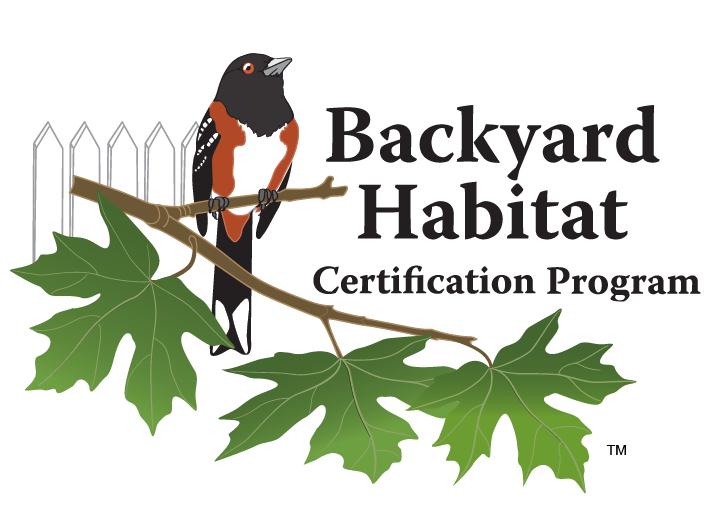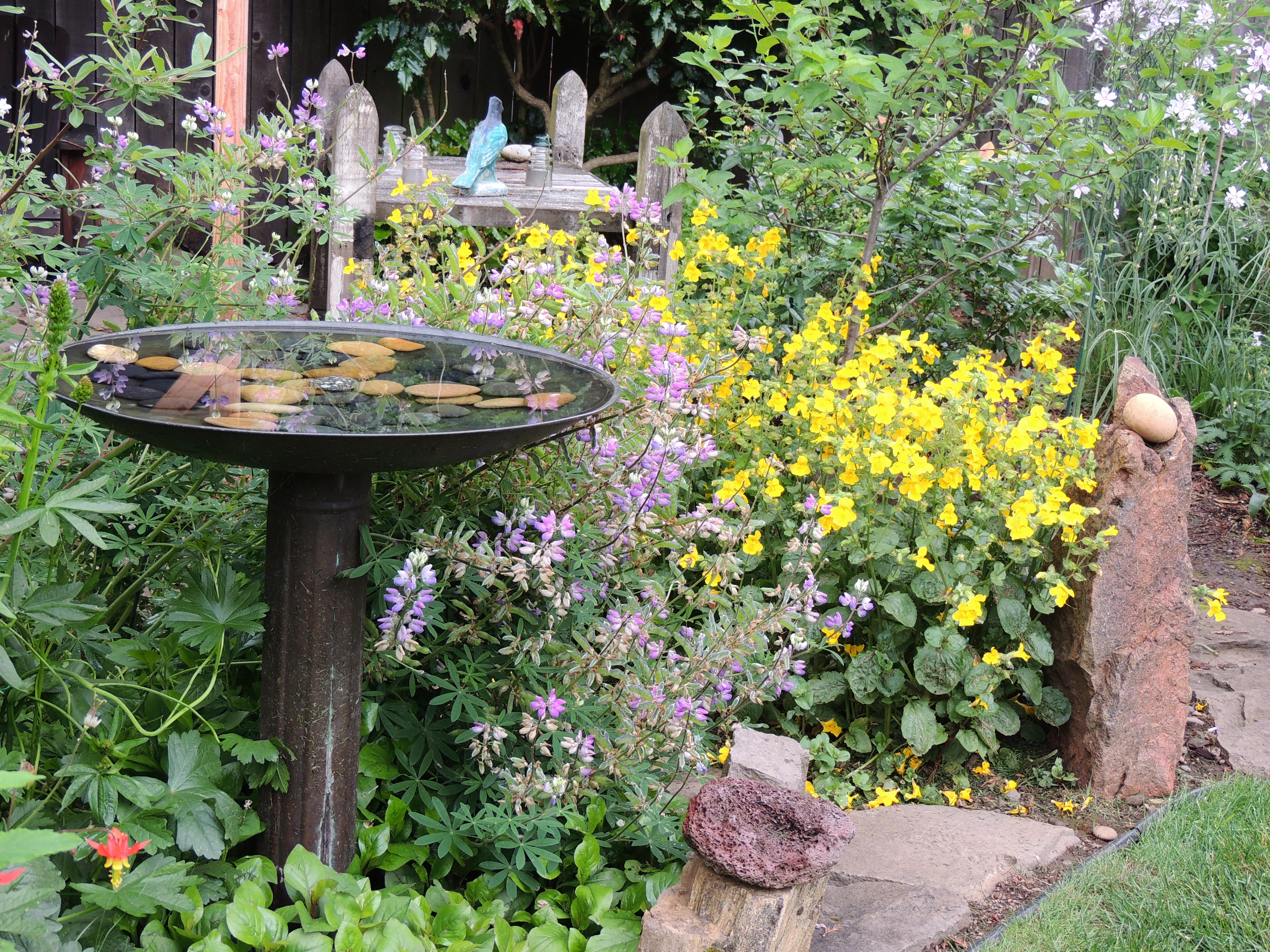Certification Criteria
Certification Criteria
We offer three levels of certification
Certification is a fun way to celebrate the progress you’ve made on your habitat project. During your site visit, the habitat technician will help you determine which elements are right for you and your site based on your goals for your space, such as enhancing your food garden, supporting pollinators, managing rainwater, or creating a relaxing space where you can enjoy birds and other wildlife.
If reaching certification is your goal, once you’ve implemented the recommendations for one of the certification levels from your site report, let us know, and a trained volunteer will schedule a certification visit with you. Once you’re certified, you’ll receive our lovely yard sign!
| Certification Table | Silver | Gold | Platinum |
|---|---|---|---|
Invasive Species | Remove all “silver” aggressive weeds. Browse Silver Weeds | Remove all “silver & gold” aggressive weeds. Browse Silver & Gold Weeds | Remove all three levels of aggressive weeds. Browse all levels of weeds |
Native Plants | Naturescape > 5% of property with locally native plants* – at least 3 out of 5 native vegetation layers | Naturescape > 15% of property with locally native plants* – at least 4 out of 5 native vegetation layers | Naturescape > 50% of property with locally native plants* – 5 native vegetation layers |
Pesticide Reduction | No use of RED zone chemicals. Use only YELLOW or GREEN zone chemicals if necessary, according to an IPM strategy. | No use of RED or YELLOW zone chemicals. Always use IPM strategy. | No use of RED or YELLOW zone chemicals. Always use IPM strategy. AND Take the Metro No Pesticides Pledge. |
Wildlife Stewardship | Choose one item from the Wildlife Stewardship list. | Choose two items from the Wildlife Stewardship list. AND If you have a cat that goes outside, you must have a strong plan in place that reduces its negative impacts on wildlife. | Choose three items from the Wildlife Stewardship list. AND If you have a cat, it must be kept inside or in an outdoor enclosure 100% of time. |
Stormwater Management | Choose one item from the Stormwater Management list. | Choose at least two items from the Stormwater Management list. | Choose at least three items from the Stormwater Management list. |
Education & Volunteerism | Choose at least two items from the Education & Volunteerism list. |
Criteria Information By Topic
Many non-native plants have been introduced into our ecosystem. All of them have some benefits for people and wildlife. However, a few have also been shown to push out native plants in ways that alter the ecosystem. The plants listed in our “invasive weeds” lists have been identified by local ecologists as having negative impacts on native plant populations, vegetation layers, erosion, or the broader ecosystem.
To achieve certification, all “invasive weeds” at or below your desired level must be removed. Example: To reach Gold level certification, all silver and gold “invasive weeds” need to be removed.
“Ninety percent of all insects are specialized, meaning they share an evolutionary history with native plants and rely on them to survive.“
—Tallamy, Douglas. Bringing Nature Home. Portland: Timber Press, 2007.
When certifying a site, we look for one or more areas with a native plant focus. These are referred to as “naturescaped” areas. An area is considered naturescaped if 50% or more of it is planted with native plants specific to our lower Willamette Valley ecoregion (based on the Portland Plant List) and includes three or more native vegetation layers.
Helpful resources:
- Our Condensed Portland Plant List spreadsheet lists those native plants that are easiest to find at nurseries and have the highest success rate.
- Our Naturescaping with Backyard Habitat presentation (4 1/2 minutes)
- Naturescaping with Natives Plants handout
The use of pesticides (including insecticides, herbicides, and fungicides) can be very harmful to wildlife, pets, and people. One benefit to planting native plants is that they don’t require pesticides. Native plants attract beneficial insects, which in turn help keep populations of undesirable insects in check.
For certification, use Metro’s Grow Smart, Grow Safe searchable interactive directory to find the least hazardous products and practices for a productive, safe and healthy yard. For platinum level certification, take Metro’s No Pesticides Pledge.
The Portland-Vancouver region sits at an incredible ecological crossroads. The confluence of two great rivers, the Columbia and the Willamette, it’s located along the Pacific Flyway for bird migration.
Of the approximate 500 bird species found in Oregon, 209 use the Portland-Vancouver region for some portion of their life cycle. Due to the abundance of water, wetlands, and diversity of native plants, it also provides crucial habitat for a myriad of pollinator, amphibian, and fish species. Help create wildlife corridors throughout the region by providing food and nesting materials for the wildlife who also call this place home.
Silver: choose at least 1 from the list below
Gold: choose at least 2 from the list below
Platinum: choose at least 3 from the list below
- Wildlife water feature (natural source, maintained bird or bug bath)
- Bird or bat nest boxes (appropriate to native species)
- Pollinator and beneficial insect nesting habitat (i.e. rock piles, bundles of stems and branches, mason bee house)
- Snag or nurse log
- Reduce outdoor lighting during bird migration (March-May, Sept-Nov)
- Reduce bird window collisions
- Native pollinator meadow which bloom through the growing season
When it rains or snows in urban areas, water washes off roofs and other surfaces, and into streets, picking up dirt, chemicals and oil along the way. Stormwater management in your yard can mimic nature by directing runoff to soak into the ground, helping to filter out pollutants and decrease or eliminate runoff from your property.
Stormwater options are different for every property. Research the most appropriate strategies for your site before implementation.
Silver: choose at least 1 from the list below
Gold: choose at least 2 from the list below
Platinum: choose at least 3 from the list below
- Large canopy tree over 30ft (cannot be nuisance species)
- Disconnected downspouts, where appropriate
- Raingardens, where appropriate
- Remove impervious surfaces and/or grass 500ft or more
- Ecoroof according to City specifications
- Increase naturescaping 10% higher than your certification level requirement
- Restore soils (i.e. leave the leaves)
- Water conservation (i.e. eliminating lawn irrigation, water in morning and evening only)
- Adopt eco-friendly maintenance practices (i.e. petroleum-free yard care tools, use landscapers from Arborist and Landscape Professionals Directory)
Take things to the next level to achieve Platinum status. Become invested in the community by learning and sharing your knowledge with others.
Silver: N/A
Gold: N/A
Platinum: choose 2 from the list below
- Recruit 2 neighbors to signup!
- Allow site to be showcased in a yard tour
- Volunteer for the Backyard Habitat Certification Program
- Attend continuing education classes (i.e. raingarden or pollinator workshops)
- Volunteer for Friends of Trees
- Participate in OSU Extension Master Gardener Programs

Vegetation Layering
Canopy Trees
Over 30 Feet
Plants:
- Oregon white oak
- Ponderosa pine
- Big leaf maple
Wildlife:
- Creepers
- Owls
- Nuthatches
- Woodpeckers
- Bats
Understory Trees
Under 30 Feet
Plants:
- Vine maple
- Cascara
- Western serviceberry
- Elderberry
Wildlife:
- Hawks
- Swallows
- Chickadees
- Warblers
- Flycatchers
Large Shrubs
Between 5 and 20 Feet
Plants:
- Snowberry
- Thimbleberry
- Red-flowering currant
- Mock orange
Wildlife:
- Thrushers
- Bluebirds
- Grosbeeks
Flowering & Small Shrubs
Less Than 5 Feet
Plants:
- Western columbine
- Cascade Oregon grape
- Yarrow
- Lupine
- Sward fern
Wildlife:
- Hummingbirds
- Wrens
- Bees
- Deer
Groundcover
Plants:
- Selfheal
- Kinnikinnick
- Wild strawberry
- Roemer’s fescue
- Wood sorrel
Wildlife:
- Juncos
- Sparrows
- Butterflies
- Beetles
Our Certification Criteria is available as a downloadable PDF.




